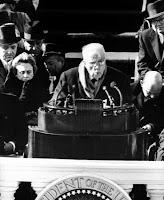Over the past decade or so, inaugural poets have been less known, but that has not meant that their poems, usually written for the occasion, have been forgotten. I remember in particular there having been quite of bit of favorable comment about the poem "One Today" read by Richard Blanco at the Obama inauguration in 2013. The comments about the poem afterwards on radio and TV showed how it had been especially accessible and meaningful to many. In his poem, Blanco employed the opening image of "one sun" rising in the eastern U.S. and moving across the continent to depict and tie together the varied lives of people as they awoke and arose to their day's regular activities. Occasionally, a specific detail added depth to the more general descriptions:
"My face, your face, millions of faces in morning's mirrors,
...on our way to clean tables, read ledgers, or save lives --
to teach geometry, or ring-up groceries as my mother did...."
The poem continued the theme of unity by using the phrases "one sky" and "one moon."That modern poem came back to my mind when I recently read, of all things, an 8th-century Buddhist stanza. It was by Yung-chia Ta-shih, and goes like this:
"One Nature, perfect and pervading, circulates in all natures,
One Reality, all comprehensive, contains within itself all realities.
The one Moon reflects itself whenever there is a sheet of water,
And all the moons in the waters are embraced within the one Moon."
Even when I was in early elementary school, and read introductory books about astronomy, scientists knew that the planets of our own solar system varied in whether they had one moon, no moon, or more than one. Astronomers' inventory of our universe is now so vast that we have numerous examples of the variety of moons that orbit about each planet in many planetary systems. We also now know that other planetary systems sometimes have not a single star but a star system at their center.
If our own solar system did have more than one sun, or if our Earth had more than one moon, I would hope we would still have poets to remind us that we are all ultimately one people. And also have poets to at times stretch our minds a little farther, by reminding us that all Life on this planet is ultimately One Life.
~~~
Is there some way you try to come back to an awareness of our unity amidst differences?
(The Japanese print is in the public domain because its copyright has expired.)
(The Buddhist verse is taken from The Perennial Philosophy by Aldous Huxley, © 1945, p. 8.)
(The 2013 poem "One Today" by Richard Blanco can be read at this external link: "One Today".)
(The 2013 poem "One Today" by Richard Blanco can be read at this external link: "One Today".)



